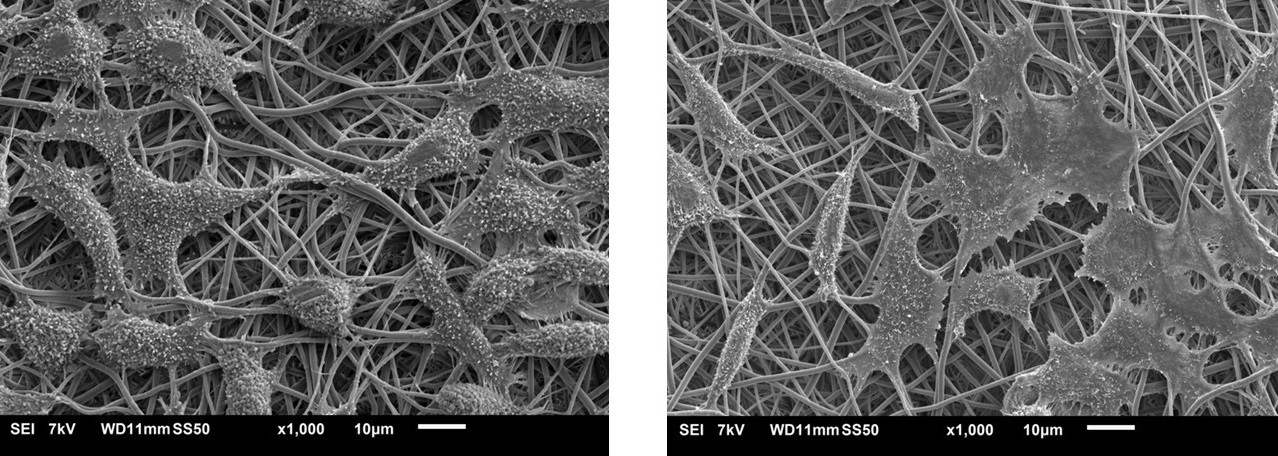On December 12, 2024, according to the resolution of the Scientific Council of IPPT PAN, Oliwia Jeznach was awarded the degree of Doctor of Science in the field of Engineering and Technical Sciences in the discipline of Biomedical Engineering.

Tissue engineering is an interdisciplinary field of science that combines biology, materials engineering, and regenerative medicine to develop innovative scaffolds - cell substrates for the reconstruction, repair, or replacement of damaged tissues and organs. By leveraging advanced technologies such as electrospinning, 3D bioprinting, and the use of stem cells, tissue engineering creates solutions with the potential to revolutionize modern medicine.
As part of a recently defended doctoral dissertation at our institute, Oliwia Jeznach, PhD under the supervision of Professor Paweł Sajkiewicz, PhD, DSc and Dorota Kołbuk-Konieczny, PhD, DSc conducted research on the surface modification of polymer fibers used as scaffolds for cell growth in tissue engineering. The fibers were obtained via electrospinning technique from three aliphatic polyesters, poly(caprolactone), poly(L-lactide), and poly(L-lactide-co-caprolactone), being one of the most commonly used polymers in the tissue engineering. Given polyesters differed in frequency of ester groups in macromolecule chain, glass transition temperature, and degree of crystallinity. The aim of the modification was to improve cell growth on the substrate by introducing amine groups onto the surface and immobilization of gelatin containing peptide sequence, which is recognized by cells. Such changes on the molecular level result in an increase in wettability and the introduction of the biological activity of the substrate. The first step of the modification was an aminolysis reaction, and the second one - was gelatin immobilization via glutaraldehyde crosslinking. Modification mechanism and impact on substrate properties and cell response were studied. The results indicated that aminolysis conducted in the same conditions proceeds slower on the fibers than on control polyester films. Moreover, it was observed that the reactivity of PCL fibers is significantly lower in comparison to PLCL and PLLA. Mechanisms of the observed dependence were presented. It has been shown that mild conditions of the aminolysis functionalization cause the introduction of sufficient quantities of amine groups on the fiber surface to improve cell response while initial fiber morphology and mechanical properties are close to the initial ones. There was the observation that both chemical and physical attaching the gelatin improved cell response. However, a superior effect and higher stability in PBS solution were demonstrated for chemical modification. It could be the result of higher amounts of gelatin or better molecular conformation, which provides exposure of peptide sequences recognized by cells.
The original contribution of the conducted research to the body of literature lies in obtaining and analyzing experimental data on the aminolysis process in submicron fibers made of aliphatic polyesters formed via electrospinning, focusing on their surface functionalization. A key aspect was comparing these results to aminolysis in polymer films and demonstrating significant differences in the reaction depending on the material’s form. Previous studies on aminolysis efficiency primarily concerned aromatic (non-degradable) polyesters in the form of films and relatively thick fibers produced by conventional spinning methods. There was a lack of systematic information in the literature regarding the aminolysis of submicron fibers from aliphatic polyesters. At the beginning of this research, aminolysis had become one of the most widely used surface modification methods for fibers in tissue engineering. Reports suggested that aminolysis proceeds more slowly on electrospun polymer fibers than on polymer films; however, this topic had not been addressed in any comparative studies. This dissertation not only systematized knowledge in this area but also identified potential causes of the observed differences. Another original contribution was the investigation of the aminolysis process and its impact over a wide range of parameters on the properties of various polyester fibers. It was noted that some studies used aminolysis as an intermediate step for attaching molecules to fiber surfaces without verifying the reaction's efficiency. The dissertation demonstrated that this approach could lead to issues, such as in the case of PCL fibers, where preliminary studies did not confirm aminolysis under commonly used parameters, showing additionally that protein attachment might occur via physical adsorption. It was further presented that such adsorption does not provide stable layers of the final material attached to the fiber surface. The research also expanded knowledge on aminolysis in electrospun fibers, considering, among other factors, differences in reaction efficiency between polyesters and its effects on molecular weight, mechanical properties, and cellular response. An original aspect of the study was the comparison of gelatin attachment to functionalized electrospun fibers made from various polyesters with differing concentrations of amine groups, as well as relating these findings to gelatin's physical adsorption. The systematic investigation of this process, including layer stability and its influence on cellular response, is particularly important given the extensive use of this method in surface modification studies. The dissertation also compared aminolysis-based method of gelatin attachment with two other commonly used approaches—hydrolysis and plasma treatment—highlighting differences in their effects on mechanical properties and cellular response.

Fig. L929 mouse fibroblasts after 5-day culture on a) unmodified, b) aminolyzed PLCL fibers.















